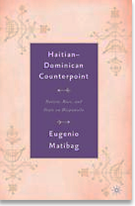 "Haiti and the Dominican Republic" by Eugenio Matibag, Ph.D.
"Haiti and the Dominican Republic" by Eugenio Matibag, Ph.D.
Matibag is Professor of Spanish and Latin American Studies and Director of the Center for American Intercultural Studies at Iowa State University. He is the author of Haitian-Dominican Counterpoint: Nation, State, and Race on Hispaniola (2003).
Ever since French King Francis I (1515-42) asked what clause of Adam’s will had bequeathed the Americas to Iberian possession, the claim to what was called la Isla Española would be contested. Indeed, the political changes that formed today’s 232.5-mile boundary also destined what would become Haiti and the Dominican Republic to share a turbulent history. This shared history begins with the encroachment of the French boucaniers and privateers of northwestern Hispaniola, where they hunted cimarrón cattle and created a colonial bridgehead, activities that intensified after the 1605 "devastations" and depopulations of the region ordered by the Spanish colonial government. The plantation economy of Saint-Domingue produced the conditions for cimarronage and slave revolts, and settlements founded by the runaways of the two sides from the two colonies. The 1697 Treaty of Ryswick that ended the War of the Augsburg League ceded the French-claimed territories; the 1795 Treaty of Basle handed the Spanish part of the island to France, which would retain it until Spanish repossession in 1809.
Although Toussaint Louverture had pledged his loyalty to Spain in the first year of the revolt in 1791, he switched to the French cause the next year when Girondin Commissioner Sonthanax brought a promise of eventual equality of rights between Haitians and French citizens. Jean-Jacques Dessalines, who had proclaimed Haitian independence in 1804, sent 25,000 troops the following year into la Partie de l’Est, where a French garrison had been established, in the Dominican capital, under the command of Louis Ferrand.
The twenty-two-year "domination" of Santo Domingo by the Haitian forces commanded by Jean-Pierre Boyer, from 1822 to 1844, materialized for Dominicans the threat posed by the insular other, and Dominican independence would be gained in that latter year in separation not from the so-called "mother country," but from the occupiers from the neighboring country. The invasions of the eastern part ordered by Haitian president Faustin Soulouque in the mid-nineteenth century were intended not only to conquer Dominican territory but also to avert the threat of a reconquest of Haiti by Spain, which it might have undertaken from a platform of a recolonized Santo Domingo.